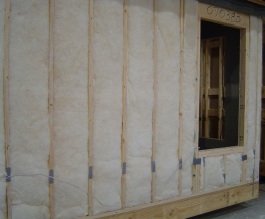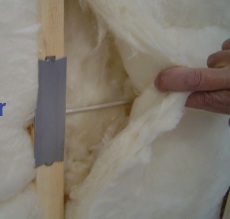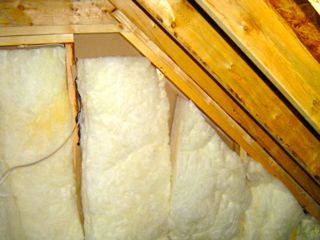ENERGY STAR Version 3 Requires Grade I Insulation

 If you read my article last week, you know that most insulation materials don’t stop infiltration, although it’s commonly believed that adding insulation is the solution to a drafty house. That’s only one of many limitations you need to be aware of with insulation. Another is that the quality of installation can greatly affect the performance of insulation.
If you read my article last week, you know that most insulation materials don’t stop infiltration, although it’s commonly believed that adding insulation is the solution to a drafty house. That’s only one of many limitations you need to be aware of with insulation. Another is that the quality of installation can greatly affect the performance of insulation.
If you read my article last week, you know that most insulation materials don’t stop infiltration, although it’s commonly believed that adding insulation is the solution to a drafty house. That’s only one of many limitations you need to be aware of with insulation. Another is that the quality of installation can greatly affect the performance of insulation.
When Version 2 of the ENERGY STAR homes program came out in 2006, RESNET updated the Home Energy Rating System (HERS) Standards at the same time. Both required a HERS rater to put a Grade – I, II, or III – on how well insulation was installed in house. Grade I is the best, grade III the worst. (Well, actually, uninsulated is the worst, but I’m talking about when you actually have insulation installed.)
A house could still qualify for the ENERGY STAR label with Grade III insulation in ENERGY STAR Version 2, but it took a hit in the home energy rating software if it wasn’t Grade I. With Version 3 of the ENERGY STAR homes program, however, Grade I will be required in most cases. The only exception is in walls that have exterior insulated sheathing (foamboard).
So, you may wonder, what is it that determines whether an installation is Grade I, Grade II, or Grade III? There are two parameters that come into play here: Missing insulation (gaps) and compression or incompletely filled areas.
The photo above is a Grade I installation. It’s in a modular home plant for a company that made the decision to build green modular homes, and the photo above is a big change from what I saw the first time I visited their plant (photo at bottom).
Notice that all the cavities are filled completely. The fiberglass batts are cut to exactly the size of the cavities they fill, they aren’t compressed, and they fill the cavities completely. As you can see in the photo at right, the batts also surround the wires instead of being squeezed behind or in front of the wires.
filled completely. The fiberglass batts are cut to exactly the size of the cavities they fill, they aren’t compressed, and they fill the cavities completely. As you can see in the photo at right, the batts also surround the wires instead of being squeezed behind or in front of the wires.
According to the HERS Standards from RESNET, to get Grade I, an insulation installation should have only ‘occasional very small gaps.’ It can have compression or incomplete fill up to 2% of the insulated area.
I’ll tell you right now, getting Grade I insulation with fiberglass batts is NOT easy. The photo above is one of only two fiberglass batt installations I’ve seen that have gotten Grade I.
 The typical installation of batts is Grade III. The photo at left shows one that gets Grade III because of having more than 2% of the area uninsulated. In this case, it’s an attic kneewall, and the insulators obviously didn’t take much time to fit the batts properly to the cavities. Their job in most new home construction is to get in and out quickly.
The typical installation of batts is Grade III. The photo at left shows one that gets Grade III because of having more than 2% of the area uninsulated. In this case, it’s an attic kneewall, and the insulators obviously didn’t take much time to fit the batts properly to the cavities. Their job in most new home construction is to get in and out quickly.
The two sides of the other parameter, compression and incomplete fill, actually go together when a cavity is insulated with fiberglass batts. In places where the fiberglass is compressed, you’re usually going to have incomplete fill in that part of the cavity. The photo below shows a wall with lots of compression, and is clearly Grade III. This photo is from my first visit to the plant of the modular builder that achieved Grade I six months later.

Grade I is definitely achievable, but it’s difficult to do with fiberglass batts. To get their insulation contractors to do it, builders are going to have to pay a premium because it takes more time and attention to detail. Even then, I imagine it’s going to be a constant battle. My friend Carl Seville, the Green Building Curmudgeon, went so far as to suggest the idea of banning fiberglass batts in his column at Green Building Advisor a few months ago.
If I were a builder of ENERGY STAR homes, I’d be looking seriously at other ways to insulate. Cellulose or other types of sprayed or blown materials are much easier to get Grade I installations with, though it’s certainly not guaranteed. Although it’s been all the rage in green building over the past few years, spray foam is not a miracle product.
With ENERGY STAR Version 3, new homes will definitely be better. The requirement for Grade I installation of insulation is one big reason for this improvement.
Note: Since I first wrote this article, ENERGY STAR revised the guidelines, and now assemblies can pass with Grade II insulation as long as that assembly has continuous insulation, too.
If you haven’t read it yet, you can download our white paper on ENERGY STAR Version 3 now.
This Post Has 6 Comments
Comments are closed.

To people outside the world
To people outside the world of building science these guidelines would seem like nonsense. This includes many of the insulation contractors out there. Less than 2% of the area uninsulated just to get above a grade II!? So that the non-believers can get a sense of the energy loss through only 2% gaps, I recommend reading your article about the attic stairs. http://tiny.cc/cn1qt
Great point, Matt! I should
Great point, Matt! I should’ve put that in the article. Being ensconced in the world of building science, though, I sometimes forget that what seems reasonable to me may cause another person to wonder if I’m off my rocker.
For those interested, here are several articles related to this topic:
Flat or Lumpy – How Would You Like Your Insulation?
Attic Stairs – A Mind-Blowing Hole in Your Building Envelope
A Dramatic Illustration of a Compromised Building Envelope
Good artical made even better
Good artical made even better with the addition of the pictures.
Keep it up
The challenge many of us face
The challenge many of us face is educating the installers. Owens-Corning has provided this document to help installers understand what is required. Good pictures and checklists. Thay can’t say that they don’t understand what is needed.
http://insulation.owenscorning.com/professionals/technical-resources/index.aspx
Walt, thanks for posting that
Walt, thanks for posting that link to the Owens-Corning document. It’s got a lot of good info & photos. It looks like either they borrowed material from ENERGY STAR or ENERGY STAR borrowed material from them because there document has some identical features to the ENERGY STAR materials we used in our Version 3 class this week.
For those wondering how to find it on that page, you have to choose ‘R-13 Fiberglass Insulation’ from the drop-down menu. (I’ve tried to make a clickable link in here, but for some reason it’s not working.)
I am working with several
I am working with several contractors to certify their homes as Energy Star. In reading the requirements for insulation grading I think it difficult at best to explain to the contractor. Some contractors want to know how I came up with the Grade other than a visual interpretation and typical comment of “batts never achieve a Grade I, maybe a Grade II and mostly a Grade III”. This is not a good enough answer. How can I as a new HERs Rater (with little experience in grading insulation) calculate the grade of insulation (on a job that isn’t obviously bad)? One reason I am perplexed is the compression of 2% area. How does this translate when working with volumes, ie the cavity. Can you provide an example of how to calculate a grade or at least clarify the grading instructions when discussing areas versus volume?